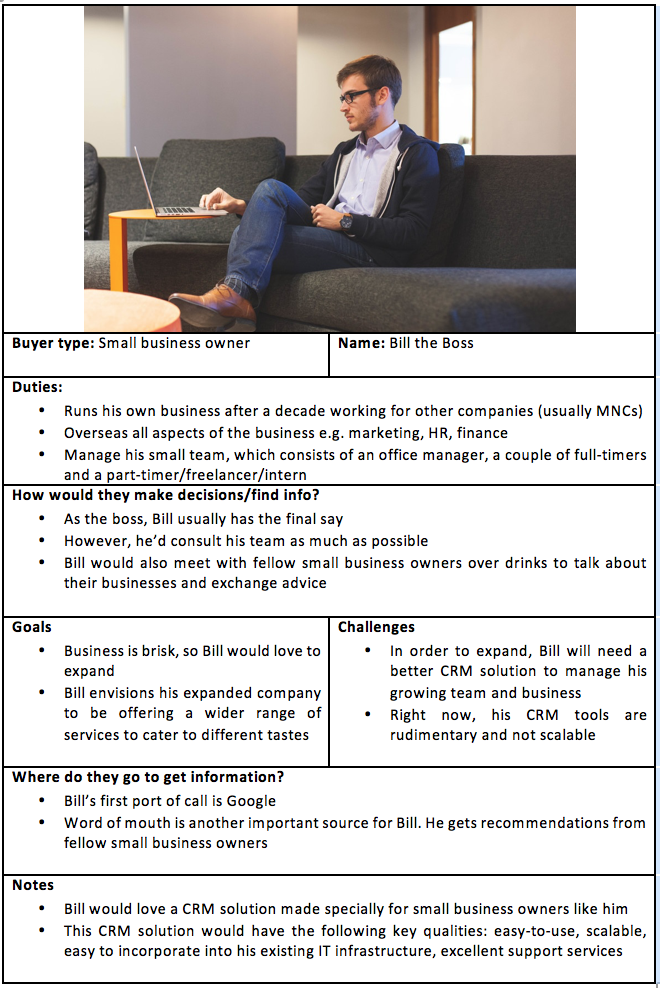

How to Create Effective Buyer Personas for Your B2B Marketing Campaigns


Bas van den Beld in the State of Digital declared:
Businesses may think they understand their target audience, but they really don’t."
Now that's a truth, if we've ever heard one.
van den Beld explained that the problem with most marketing campaigns[1] is that they are too product-centric, when they should really be focusing on the buyers. The folks over at B2B Marketing[2] and Business2Community[3] have also highlighted this as a stumbling block for marketers.
Our solution: Axe “target audience” from their vocabulary. Replace it with “buyer persona”.
Seek First to Truly Understand Your Buyers, Then be Understood by Them
Do marketers know what it means to truly “know your target audiences”? The problem with this hackneyed advice is that groups that are often thought of as target audiences—such as “young working adults”, “HR managers” and “stay-at-home Dads”—are still too nebulous to be useful.
Here's a thought: Instead of trying to figure out an abstract group like “millennials,“ what if you actually had a millennial in mind?
Not a flesh-and-blood one, but an accurate representation based on a deep understanding of your ideal millennial customer. That’s your buyer persona.
When done right, you’ll know your buyer like you would know your friend.
Your marketing efforts become more targeted and personalised. Your buyer is no longer just an entry in your database, but someone whom you took the pains to understand. As a result, when you interact with real potential buyers, they don’t think “not another marketing hack trying to shove their stuff in my face” but “wow, these guys get me!”
That’s what it means to truly know your target audience put the buyer at the center of your marketing campaign.
The Making of a Buyer Persona: Fiction from Facts
Although it is fictional, the buyer persona is grounded in factual evidence garnered from extensive research and discussions with your actual customers. We’ll illustrate the buyer persona development and creation process by creating one here.
Scenario: you are the marketer of a B2B company that sells customer relationship management (CRM) software. You want to target the small business owner community. How would you carve a buyer persona out of the thousands of small business owners out there?
Step 1: Identify Questions to Ask
Begin by compiling questions to ask in order to build your personas. We’d ask questions in these areas:
- Decision making: Who makes the decisions here?
- Getting info: How does he find information that he needs?
- Goals: What does he want to achieve?
- Challenges: What's preventing him from reaching his goals?
- Who are they and what they like: What is his job scope and responsibilities? What makes him happy?
- Company size: Number of people in the company.
- Dislikes and desires: What does he really hate in his job? What does he want from it?
These questions should be specific to your industry. Our small business owner example: How are you currently managing your existing customer relations? What are the challenges you face in managing customer relations on your own? What solutions have you tried?
Step 2: Get Your Answers
Get your customers’ needs, challenges, and interests etc. from your customers!
Tap into your existing customer base and learn as much as you can via surveys, interviews, and feedback from discussions. Your colleagues who interact with customers – such as the sales team and tradeshow representatives – are another great source of information.
Next, branch out to adjacent sources such as social media listening tools, trade journals, and articles written by industry influencers.
Step 3: Compile Those Answers
Amass and sieve all the information that you collected. As you sort through the data, you will notice similarities and trends. Start categorising these similarities into broad buckets such as goals, challenges, how they seek information, and more (see Step 1).
Now you're ready to start sculpting your buyer persona with these common traits in mind.
Step 4: Bring Your Persona to Life
By now, you should have a fictionalised representation that you are intimately familiar with. Don’t just stop there! Give your persona a name, put a face to it, and build a story around him. Remember, the person should be at the heart of your campaign – not your product – so make your persona as human as possible.
As an example, here's our Small Business Owner Persona.

Your buyer persona should be full of details to be useful. The buyer persona table used in this post is also included in our 4-step B2B Marketing Campaign Plan as a template for your use in your B2B Marketing campaigns.
One last thing to note about buyer personas: they are not set in stone.
Your actual buyers may change over time in terms of preferences, challenges, needs etc. Remember to keep in touch with real customers and industry news! Doing that will keep your buyer personas fresh and relevant to your business.
Like what you read? Subscribe to our B2B Marketing Posts for more good stuff!
Credits & Sources
Header image from Search Engine Land
Image of male from Pexels
[1] 2 Reasons Marketing Campaigns Fail (src: State of Digital)
[2] Why Do Online B2B Marketing Campaigns Fail? (src: B2B Marketing)
[3] 3 Reasons Why Your Marketing Campaign Failed (src: Business 2 Community)
More insights
